
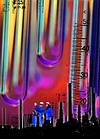
Just as the semiconductor industry is achieving increasingly higher levels of integration, analysis technology is advancing into lower measurement ranges.
In analogy to Moore's Law of the semiconductor industry, measurement resolution for emission gas monitoring has halved at an impressive regularity of every two to three years.
Measurement data and processes
The automotive industry has reduced nitrogen oxide pollution levels by progress in engine technology. Oxidating catalytic converters (oxicat) provide further emission reductions. For larger applications, ranging from diesel engines for trucks to gas fired power plants, these methods are insufficient.
In California for example, NO emission from gas-fired plants may not exceed 5 ppm. DeNOx catalytic converters based on the SCR (selective catalytic reduction) permit the fulfilment of these requirements. Such converters rely on dosing with urea or ammonia to remove NO.
To provide the correct doses, accurate knowledge of NO, NO2 and NH3 concentrations in the exhaust gas are a prerequisite. The process relies on sensitive measurement equipment.
In the automotive industry, measurements are performed either in a laboratory test set-up or on a moving test vehicle. In a power plant, the measurement must be performed directly in the chimney flue.
Detection by resonance
Limas11 HW of the AO2000 gas analyser series detects the presence of very small concentrations of NO gas in a sample by analysing the absorption resonance of the gas to specific light frequencies.
Resonance spectroscopy is a unique approach in the field of UV photometers. While the principle may sound straightforward in theory, the practical realisation of such a set-up requires greater sophistication. Noise from such sources as impurities in the apparatus and variations in the light must be taken into account.
Light source
The light is produced in an electrodeless (EDL) source: A high frequency field generates plasma from a mixture of N2 and O2 in a quartz bulb. Excited NO is formed, which, on reverting to its ground state, emits ultra-violet radiation with the characteristic spectrum of NO (oscillation and rotation transitions) - Figure 1. Some molecules do not immediately achieve their ground state but fall to an excited state. As shall be explained later, Limas11 HW uses the radiation from this transition as reference radiation.
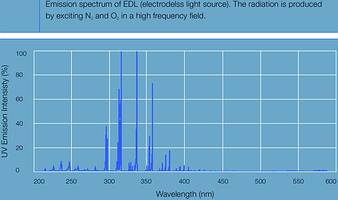
Resonant absorption (Figure 2)
The light beam from the EDL source (2a) is split into two beams using a semi-transparent mirror (2b). One of these beams is directly captured by the first detector (2c) and the other is directed through a cell containing the measuring gas (2d). If the measuring gas contains traces of NO, it marks its presence by absorbing some of the radiation.
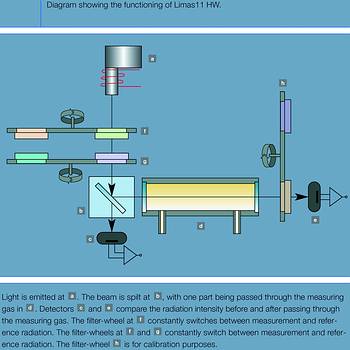
On leaving the measuring cell, the beam is captured by another detector (2e). Comparison of this measurement with that of the first detector compensates for changes of the light intensity caused by the EDL light source or temperature effects of the filters. This is, however, not sufficient for achieving the required accuracy. Resonant absorption by NO cannot be distinguished from the effects of attenuation of the beam on its passage through the gas and glass, or the influence of contamination.
For an accurate indication of resonant absorption, the attenuation must be taken into account. This is where the reference radiation is used.
Reference radiation
Reference radiation is used to distinguish absorption from attenuation. It is emitted by NO in the plasma and occupies the same frequency band as the measurement radiation but is not subject to resonant absorption by NO in its ground state. It is, however, subject to the same attenuation and can be used to quantify this.
By comparing the intensity drop of the measurement radiation on passing through the measuring gas with that of the reference radiation, the effects of attenuation and absorption can be separated.
A filter-wheel is placed between the light source and the first detector (2f). Different filters permit the passage of either the total radiation (measurement plus reference radiation) or only the reference radiation.
The resonant absorption for the measurement radiation is extracted using double quotient signal processing (Figure 3). This method makes the measurement very tolerant of impurities: The measurement cell can accumulate dirt without this affecting the result of the measurement. In an extreme situation, measurement remains possible even with the cell half full of water.
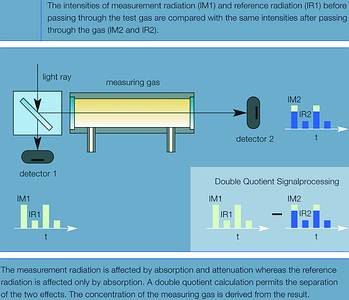
Set-up of the filter wheel
A classical filter wheel is powered by a constant-speed motor. As the windows themselves are small, the light pulses are applied to the test gas during only a short part of the total measurement cycle. Limas11 HW uses a stepped motor that permits pulses to be applied during a considerably longer part of the cycle (Figure 4). This mechanism increases the signal to noise ratio by a factor of 2 to 3.
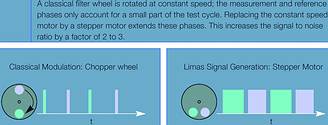
Measuring cell design
Further sensitivity is added to the measurement through the design of the measuring cell. Instead of the usual arrangement with the gas entering at one end and exiting at the other, the cell of Limas11 HW has a central inlet with outlets at the outer ends (Figure 5). The advantage of this arrangement is that soot and dirt particles collide with the wall opposite the inlet where they are adsorbed. Coating of the windows of the measurement cell by this dirt and soot is greatly reduced. This is especially important for small measurement ranges.
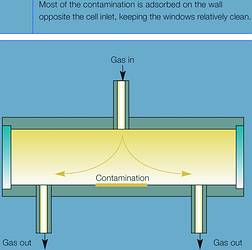
Safety
The cell has a gas purging arrangement. Purge gas is passed through chambers adjoining the cell windows (Figure 6). Leaks in the window gaskets or a breakage of the glass are quickly detected through monitoring of the purge gas. The purging arrangement also ensures that any leaked test gas is removed safely.
This approach uses standard components and replaces elaborate constructive measures such as separate enclosures for optics and electronics (to prevent gas from contaminating the air within the set-up and so affecting results). Flammable, corrosive or toxic gases can be safely measured with a simple set-up.

Calibration
Calibration is a simplified process performed with a quartz cell containing a measurement component, resulting in system and time cost savings. The noteworthy long-term stability of a calibration cell is shown in Figure 7.

Multicomponent measurements
The measurement set-up can easily be extended for measuring several gases simultaneously. Additional windows can be added to the filter-wheels to cover additional frequencies. For example, in a DeNOx denitrogenation process, NO, NO2 and NH3 can all be measured at the same time.
Remote maintenance via software
AnalyseIT Explorer makes all available data visible and accessible for remote maintenance on Ethernet TCP/IP networks. Maintenance outlay can be reduced and predictive maintenance raises reliability.
Applications
This analyser offers an alternative to established CLD (chemiluminescence) analysers. Major advantages in comparison to CLD analysers are:
* No ozoniser/deozoniser: less maintenance.
* No high vacuum pump: less maintenance.
* No quenching for other measuring components such as H2O or CO2: less cross-sensitivity.
Potential applications for the analyser in the automotive industry include development activities for vehicle engines, larger engines (as used in ships), catalytic converters, automotive pollution treatments and the production of test gas bottles.
Combustion plant developers can use it for developing combustion chambers, burners, combustion engineering and pollution treatments. The equipment can also be used by suppliers of DeNOx plants, gas turbines, gas-fired burners and for stack testing.
For more information contact ABB South Africa, 011 236 7616.

© Technews Publishing (Pty) Ltd | All Rights Reserved